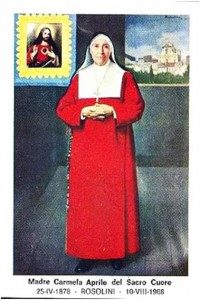 With the upcoming premiere of the Film “Cor Jesus Mecum Est” on September 28, 2018 in Rosolini, Italy, a film that touches the themes of a holy Rosolini woman, Mother Carmela Aprile, her devotion to the Sacred Heart and attendant miracles, and the ultimate formation of a Visitation Monastery in that city to be responsible for the Sanctuary of the Sacred Heart, we want to encourage your prayerful support by reviewing some aspects of this history.
With the upcoming premiere of the Film “Cor Jesus Mecum Est” on September 28, 2018 in Rosolini, Italy, a film that touches the themes of a holy Rosolini woman, Mother Carmela Aprile, her devotion to the Sacred Heart and attendant miracles, and the ultimate formation of a Visitation Monastery in that city to be responsible for the Sanctuary of the Sacred Heart, we want to encourage your prayerful support by reviewing some aspects of this history.
A Conference was held on the theme “The Sacred Heart in Rosolini” and the speaker was Dr. Rosario Puglisi, who was born and raised in Rosolini.
Dr. Puglisi narrated the history of the Monastery of the Visitation of Rosolini, known more commonly with the name and definition of Sanctuary of the Sacred Heart. Founder Carmela Aprile has become the Mother of all Rosolinesi and her name
has become inseparable from what represents the identity of the Rosolinesi.
 Carmela Aprile, born April 25, 1878 in Rosolini in a poor family, was orphaned as a child and in addition to the pain of losing her loved ones,she suffered further privations and hardships.
Carmela Aprile, born April 25, 1878 in Rosolini in a poor family, was orphaned as a child and in addition to the pain of losing her loved ones,she suffered further privations and hardships.
Memorable and precious in the historical and collective memory of theRosolinesi, her gesture of profound and sincere devotion brought her in 1907 to buy for 3 lire, the current image of the Sacred Heart. The image with its profound sweetness has become the symbol of a religiousness authentically rooted in the depths of the heart. In the modest house
of Carmela began the intense devotion to the cult of the Sacred Heart. There in Carmela’s house in via Toselli, today via Sacro Cuore, has become, through the years, a destination for devotees, needy and even malefactors looking for forgiveness, as well as faithful, grateful for the graces received.
To all Rosolinesi is known the miracle of the cistern which occurred in a period of long drought that afflicted the city of Rosolini. At that time Mother Carmela drew water from the cistern and then, when the cistern emptied, Mother Carmela came down with the bucket with a little picture of the Sacred Heart, the cistern then immediately began miraculously to fill with water.
That cistern then became the crypt in which Mother Carmela rests in repose from August 1968.
During the Conference, Dr. Puglisi narrated the events and the lives of many other characters and many other religious who have spent their lives along and inside the streets of the City of Rosolini, leaving each to proper way, indelible traces in the stories and memories they have made and which are part of the Rosolinesi Identity.
Among the many characters that have been remembered, there are the names of:
Sister Colomba, Sister Serafina, VHM Sister Elena VHM Sister Emmanuela Panelli VHM besides
those of: Mons. Ettore Baranzini, Bishop of the diocese of Syracuse, Mons. Giuseppe Vizzini, Mons. Angelo Calabretta, Mons. Salvatore Nicolosi, Bishops of the diocese of Noto, Monsignor Corrado Mingo, bishop of the diocese of Trapani, Don Carlo Sigona, Don Liborio Ardilio, Don Giuseppe Saletti, of many nuns, Mayor dr. Giovanni Cartia, Dr. Luigi Terminello, and others.
 Rosolinesi’s essential element is the relationship that these have with the Sacred Heart; a very deep and intimate relationship that is the same time is familiar and confidential, and reverential above all. Rosolinesi totally entrust their hearts
Rosolinesi’s essential element is the relationship that these have with the Sacred Heart; a very deep and intimate relationship that is the same time is familiar and confidential, and reverential above all. Rosolinesi totally entrust their hearts
to the Sacred Heart and they live it as a certain and fundamental point for their Identity. This total devotion becomes visible and perceptible in the moment of the Procession along the streets of the City, when the Citizenship accompany the Holy Image in the city streets. And here the Sacred Heart becomes like a beacon in the middle of the sea, the lighthouse of a safe harbor.
Rosolini finds his direction, his certainty, in this lighthouse identity that is discovered and confirmed through the historical memory, so that the awareness of one’s roots and belonging can become an even stronger and even more valid motive in favor of one’s own Identity, recognized and experienced also in different parts of the world, but that always and however is connected to the Land of Rosolini, along those same roads traveled by the image of the Sacred Heart, as if it were a warning, to keep the memory awake and alert. A comfort understood as a certainty of one’s own identity; a warning
understood as capacity and will on the part of the entire Rosolinese Community not to forget and not to lose the characteristics that reveal it and that belong to their Identity.